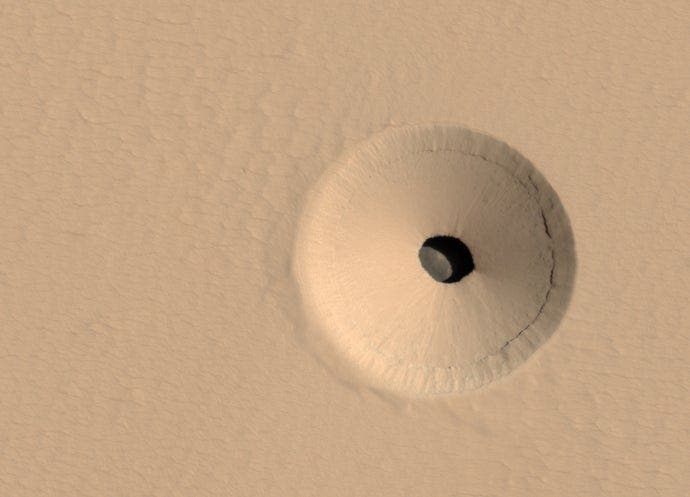Martian cave entrances may offer the perfect radiation shelter for human

There are very good reasons why Mars is such a desolate, barren landscape. With no thick atmosphere nor a magnetic field, the Red Planet’s surface is bombarded daily by radiation up to 900 times higher than seen on Earth. However, some places are sheltered. New research has found that cave entrances are shielded from the harmful radiation that normally hits Mars. This may make them ideal as both sites for future settlements and robotic missions meant to scour for signs of alien life.
Despite amazing advances in space exploration in the last decade, if we’re going to take the idea of settling Mars sometime during this century seriously, there are many challenges that need to be overcome. That’s unless we’re content with one-way suicide missions.
There’s no shortage of environmental hazards out to kill any astronaut bold enough to dare set foot on Mars. For one, the planet only has 0.7% of Earth’s sea-level pressure, meaning any human on Mars must wear a full pressure suit or stay barricaded inside a pressure-controlled chamber, otherwise oxygen wouldn’t flow through the bloodstream and the body could swell and bleed out.
Then there’s the issue of radiation. Mars is farther away from the Sun than Earth, receiving roughly 60% of the power per square meter seen on a similar site on Earth. But since Mars doesn’t have a magnetic field to deflect energetic particles, coupled with the paper-thin atmosphere, its surface is exposed to much higher levels of radiation than Earth. Furthermore, besides regular exposure to cosmic rays and solar wind, it receives occasional, lethal radiation blasts due to strong solar flares.
Measurements performed by the Mars Odyssey probe suggest that ongoing radiation levels on Mars are at least 2.5 times higher than what astronauts experience on the International Space Station. That’s about 22 millirads per day, which works out to 8000 millirads (8 rads) per year. For comparison, the people in the U.S. are exposed to roughly 0.62 rads/year on average.
Any attempt to colonize the Red Planet will require measures to ensure radiation exposure is kept to a minimum. Some of the proposed ideas thus far involve habitats built directly into the ground or even above-ground habitats using inflatable modules encased in ceramics.
But a better idea may be to take advantage of the natural shelters already in place. Mars is dotted with deep pits, caves, and lava tube structures across its surface. According to a new study performed by researchers led by Daniel Viúdez-Moreiras at Spain’s National Institute for Aerospace Technology, many of these caverns could offer ample protection to human settlers.
“Caves and their entrances have been proposed as habitable environments and regions that could have preserved evidence of life, mostly due to their natural shielding from the damaging ionizing and non-ionizing radiation present on the surface. However, no studies to date have quantitatively determined the shielding offered by these…
Read More: Martian cave entrances may offer the perfect radiation shelter for human
